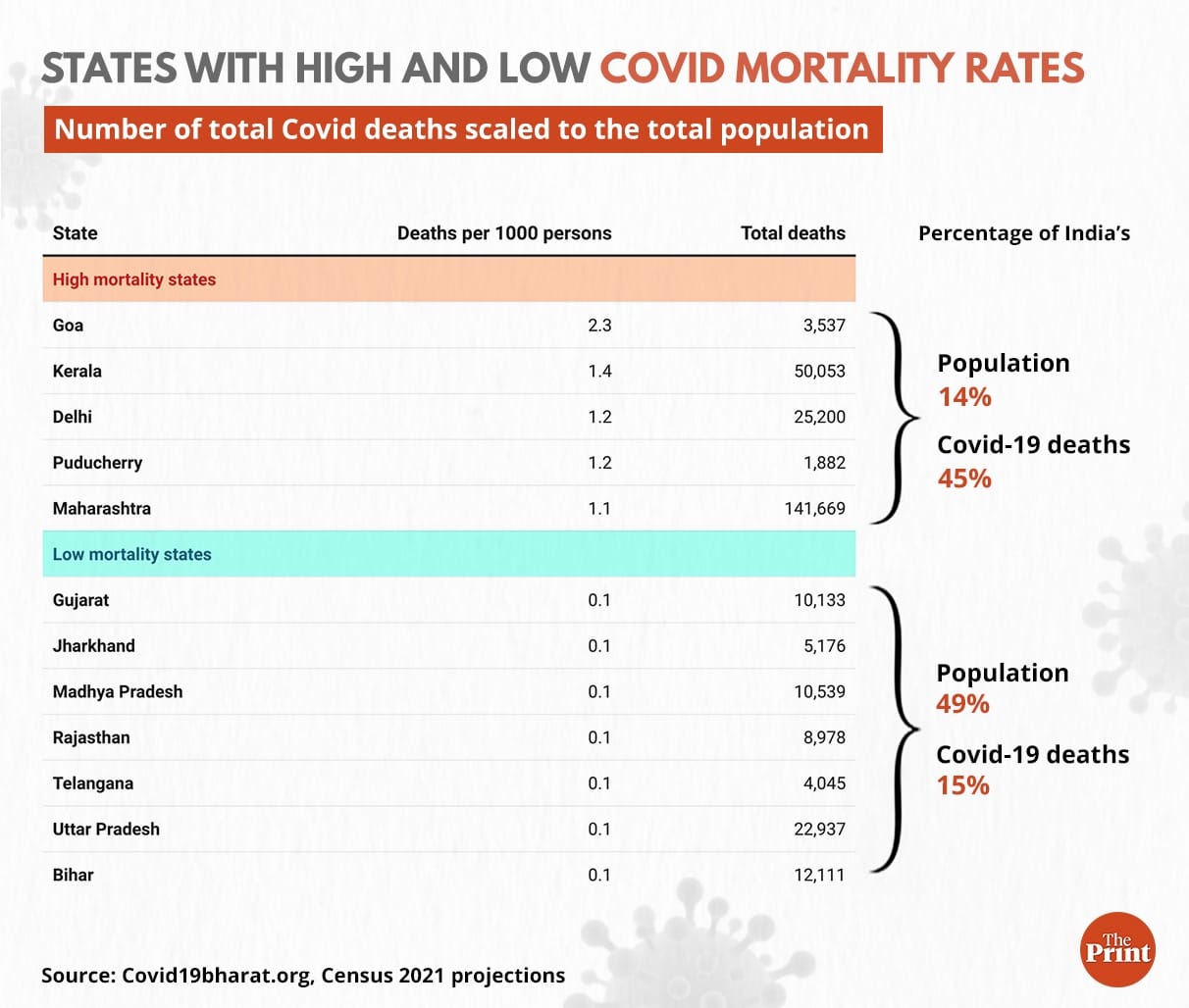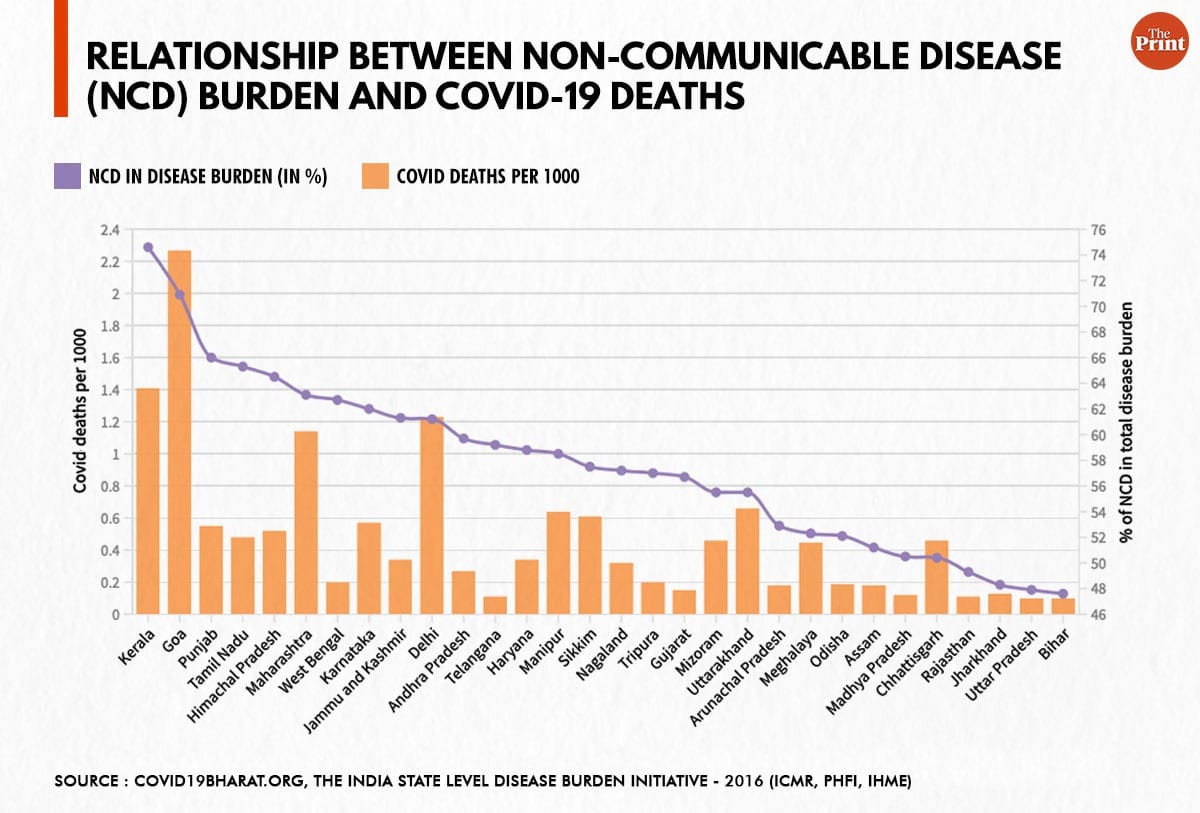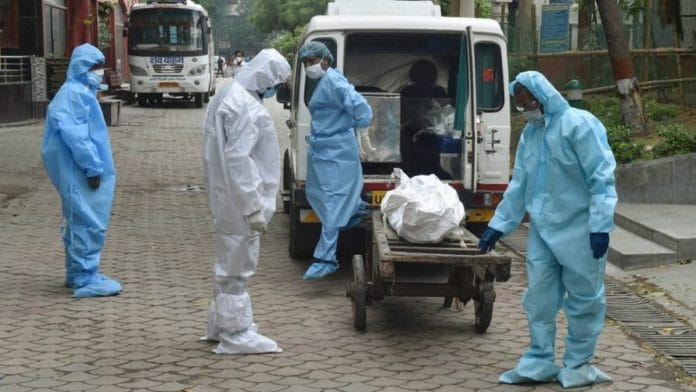New Delhi: India reported its first Covid-19 case in January 2020, in Kerala. Two years later, nearly one in every 1,000 people in the state is estimated to have died in the pandemic. And it’s not just Kerala, according to the Covid data published on crowdsourcing platform covid19bharat.org (which compiles data from state-wise health bulletins), there are at least four more states and Union territories — Goa, Maharashtra, Delhi and Puducherry — where the virus has killed with almost a similar ferocity.
An analysis of all the states and UTs shows that the magnitude of Covid-19 deaths in a state is directly related to the spread of cases.
There also seems to be a direct correlation between a higher rate of mortality in the most-affected states and the level of comorbidities in their population.
However, experts say, possible gaps in Covid deaths data hampers a definite conclusion on this point.
Using the Census population projections provided by the Union Health and Family Welfare Ministry for 2021, ThePrint analysed Covid-19 deaths in different states and UTs.
Goa, a state heavily dependent on tourism, appears to have been the hardest-hit.
The Census projections suggest Goa has a population of about 15.59 lakh. By 12 January 2021, the state had reported 3,539 Covid deaths. The number is far lower than the fatalities in neighbouring Maharashtra, 1.4 lakh. However, when scaled to population, this suggests one in at least every 500 people has died of Covid-19 in the state.
The equivalent figure for Maharashtra is 1 in every 1,000 people. By Wednesday, about 1,41,701 people had died of Covid in the state, which has a projected population of about 12.43 crore.

Goa is followed by Kerala, where after reconciliation of unreported deaths, the Covid-19 toll reached above 50,000 Wednesday. Kerala’s current population is projected to be around 3.5 crore, which suggests Covid-19 has killed one in every 1,000 people.
Delhi, which is home to an estimated 2.07 crore people, has reported 25,200 deaths to date. Here, too, the death rate is estimated at one in every 1,000 people. Puducherry, a Union territory surrounded by Tamil Nadu, has reported 1,883 deaths. Its population is estimated at 15.72 lakh.
The aforementioned five states and UTs account for just about 14 per cent of the country’s population, but have reported nearly half of India’s pandemic deaths so far.
India’s overall pandemic toll has climbed up to 4,84,688 — roughly one death for every 3,000 people.
Meanwhile, in seven states — Gujarat, Jharkhand, Madhya Pradesh, Rajasthan, Telangana, Uttar Pradesh and Bihar — there has been one Covid-related death for every 10,000 people.
Clubbed together, these seven states host about half of India’s population (48 per cent), but have reported only 15 per cent of the country’s Covid deaths.
Also read: Current Covid surge twice as fast as 2021’s 2nd wave, cases see 10-fold jump in 23 days
Comorbidities provide some explanation
The much higher rate of mortality in the most affected states can probably be explained by the level of comorbidities existing in their population.
“Some part of this discrepancy could, of course, arise because Kerala, for example, has the oldest population among Indian states and there is a high incidence of the sort of comorbidities that seem to predispose one to an adverse disease outcome upon infection,” said Gautam Menon, professor of Physics and Biology at Ashoka University in Sonepat. “The likelihood of dying of a Covid-19 infection rises very steeply with age.”
One possible way to explain the trend of Covid deaths is to look at specific states’ burden of non-communicable diseases (NCDs) — cancer, cardiovascular ailments, diabetes, chronic respiratory diseases and all the other diseases that aren’t contracted by contact with others.
The share of NCDs to the total disease burden in states was recorded in a report titled ‘India: Health of the Nation’s States’, which was published jointly in 2017 (data till 2016) by the Indian Council of Medical Research (ICMR), health policy think tank Public Health Foundation of India (PFHI), and the Institute for Health Metrics and Evaluation (IHME), an independent health research organisation at the Washington University’s school of medicine.
Analysis of the information in this report against Covid death figures shows a high and positive degree of correlation between the non-communicable disease (NCD) burden of a state and the number of coronavirus deaths for every 1,000 people.
The coefficient of correlation between Covid deaths and the NCD burden for all states was 0.7 — which is moderately high. In simple words, in 70 per cent of observed states, a high NCD prevalence was accompanied by high Covid mortality and vice versa.

Goa, for example, has a high non-communicable disease burden of about 71 per cent (the ratio of NCD patients to total patients suffering from all diseases, or the total disease burden).
The NCD burden in Kerala, Maharashtra and Delhi was also above 60 per cent, according to the 2017 report.
In states with fewer Covid mortalities, meanwhile, the NCD burden is also reportedly less: 47.6 per cent in Bihar, 47.9 per cent in Uttar Pradesh, 48.3 per cent in Jharkhand, 49.3 per cent in Rajasthan, and 50.5 per cent in Madhya Pradesh.
“Certainly, various comorbidities, including those related to NCDs, can increase the risk of death from Covid-19. Also, an older population, on average, will suffer more from diseases such as diabetes and COPD (chronic obstructive pulmonary disease), and this should have been taken into account. In general terms, such a correlation would not be surprising, perhaps even expected,” said Menon.
However, Menon added, the “existence of such a correlation hinges on the death reporting being accurate”.
“Everything we know points to a very inhomogeneous situation regarding the reporting of deaths, with different states varying widely in this regard. For that reason, I would be wary of taking this correlation seriously,” Menon said.
Mortality numbers can change
The number of deaths reported by states is likely to change in light of a 2021 Supreme Court order — under which state governments have to simplify the process under which a death could be certified as due to Covid-related causes and also to provide ex-gratia to the families of the deceased.
Following the order, the Kerala government has added 15,564 backlog deaths since late October last year.
In Maharashtra, about 1.62 lakh people had applied for the ex-gratia as of December end, while only 1.46 lakh deaths have been reported as due to Covid. This suggests more reconciliations of possible backlogs may be in order, although the authorities in Maharashtra are vetting the applications for possible duplication.
In Goa as well, backlog deaths have started appearing in the state’s tally as people rush for financial claims.
(Edited by Saikat Niyogi)
Also read: Covid hospital admissions in Delhi stabilised, cases on rise: Jain






